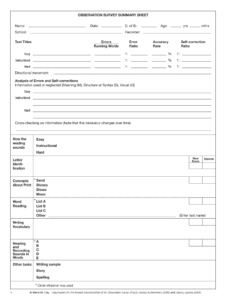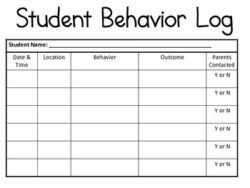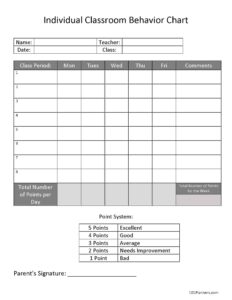Navigating the unique journey of caring for or teaching individuals with special needs often involves a delicate balance of observation, understanding, and strategic support. There are moments of joy and incredible progress, but also times when challenging behaviors can emerge, leaving caregivers and educators feeling puzzled about their root causes and the best ways to respond. It is a common experience to wonder if there is a clearer way to track these patterns and gain insights.
This is where a structured approach can make all the difference. Imagine having a tool that helps you move beyond guesswork, allowing you to systematically record and analyze behaviors. Such a tool can shed light on triggers, effective responses, and the overall context of a child or student’s actions. It provides a foundation for better communication, more targeted interventions, and ultimately, a more supportive environment.
Why a Behavior Log is a Game Changer for Special Needs
A carefully maintained behavior log is more than just a diary of events; it is a powerful data collection instrument. For individuals with special needs, behaviors are often a form of communication, a way to express needs or feelings that they might not be able to articulate verbally. By consistently documenting these behaviors, you begin to uncover hidden patterns and identify potential triggers that might otherwise go unnoticed in the busy daily routine. This crucial first step helps transform reactive responses into proactive strategies.
Furthermore, a comprehensive behavior log serves as an invaluable communication tool among all the people involved in a child or student’s life. Parents, teachers, therapists, and other caregivers can refer to the same set of objective data, ensuring everyone is on the same page. This shared understanding fosters a collaborative approach, allowing each team member to contribute to a cohesive support plan, rather than working in isolation with varying perceptions of what is happening.
The insights gleaned from a detailed log can directly inform intervention strategies. When you can pinpoint the “when,” “where,” and “why” behind a behavior, you are better equipped to design and implement targeted support. Perhaps a particular time of day consistently brings out frustration, or certain environments seem to heighten anxiety. With this information, adjustments can be made to the schedule, environment, or teaching approach, leading to a significant reduction in challenging behaviors.
Moreover, relying on concrete data moves you away from subjective interpretations. Instead of saying “he’s always disruptive,” a behavior log allows you to say “on Tuesdays after lunch, he exhibits hand flapping and vocalizations for approximately five minutes, often following a change in activity.” This level of specificity is essential for creating effective Individualized Education Programs IEPs or behavior intervention plans BIPs, as it provides a baseline for measuring progress and determining the effectiveness of any new strategies.
Ultimately, having a solid behavior log template for special needs empowers caregivers and educators. It provides them with objective evidence to advocate for their child or student, whether in school meetings, therapy sessions, or medical consultations. It demonstrates a commitment to understanding and supporting the individual, ensuring their unique needs are met with precision and compassion.
What to Include in Your Behavior Log
- Date and Time of the incident
- Location where the behavior occurred
- Antecedent what happened immediately before the behavior
- Description of the Behavior objective, measurable details
- Consequence what happened immediately after the behavior
- Duration and Intensity of the behavior
- Intervention Attempts what was done to address the behavior
- Observations and Notes any other relevant information or context
This detailed approach ensures that you capture a full picture of each incident, making your data more robust and useful for analysis.
Crafting Your Own Effective Behavior Log Template
Creating a behavior log template does not need to be complicated. The beauty of a template is its adaptability. You can choose to use a simple notebook and pen, a printed sheet you fill out by hand, or a digital document like a spreadsheet or a dedicated app on a tablet or phone. The most important aspect is choosing a format that you find easy to use consistently, as regular logging is the key to uncovering those important patterns and insights.
When developing your template, think about the specific needs of the individual you are observing. While core elements like date, time, and behavior description are universal, you might want to add custom fields. For instance, if sleep patterns are a concern, you might include a section for “hours slept last night.” If diet seems to play a role, a “recent food intake” field could be beneficial. The goal is to make the template a practical tool that reflects the unique nuances of the individual’s life.
Consistency in logging is paramount. Try to establish a routine for recording behaviors as soon as they occur, or at least at regular intervals throughout the day. Waiting too long can lead to forgetting crucial details or mixing up the sequence of events. Encouraging all caregivers to use the same template and understand the definitions of behaviors can further enhance the reliability and validity of the data collected, making it a truly collaborative effort.
Remember that the behavior log template for special needs is a living document. It should evolve as you learn more about the individual and as their needs change. Do not hesitate to modify it to better suit your ongoing observations or to reflect new goals. Regularly review the collected data with the entire support team to identify trends, celebrate successes, and adjust strategies as needed, ensuring that the log remains a dynamic and effective tool for positive change.
The process of systematically tracking behaviors through a dedicated log can profoundly change how you understand and support individuals with special needs. It transforms challenges into opportunities for growth, replacing frustration with focused action and informed decisions. This objective data helps build a clearer narrative, ensuring that every intervention is tailored, meaningful, and aimed at fostering a more inclusive and supportive environment.
By embracing this tool, you are not just recording incidents; you are actively participating in a journey of discovery and empowerment. You are providing a clearer voice for those who may struggle to express themselves, creating a pathway toward greater independence, improved well-being, and a brighter future.


